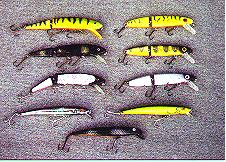This
time round I am going to state some of my views on lure colours. I know that this
subject has been covered previously in Pike and Predators, so I hope what follows
covers some new ground. All I can speak from is my own experience, and unlike
some writers I don't make things up to support my theories, rather I fit the theory
around the facts.
First
of all, let's get the eye thing cleared up. It sounds great that prominent eye
spots should attract a pike's attention and provide it with a target on the lure
body. This certainly sounds like it makes sense, and if you are anything like
me you will have succumbed to this theory at some time and painted or stuck large
eyes on to many of your lures. Baits adorned in this way definitely look to me
like they should catch more fish. Unfortunately lures that have small eye spots,
one eye missing, or no eyes at all also catch fish. I for one can not discern
any difference in catch rate between any of these lures.

Simple but effective home paint jobs.
Many,
many surface lures have eyes that are visible to the angler - on top of the lure
- but invisible to the pike. Two of the all time classic musky jerkbaits, the
Suick Thriller and the Eddie bait have tiny eye spots, or none at all (the Eddie).
Both have caught thousands of fish - that is how they became classics.
Spoons
are one of the oldest lure types around, and along with spinners, very few examples
have any eye spots to be seen. Same goes for most soft plastic lures, and all
these are excellent producers of pike. So why do these lures work so well? The
answer is simple. It is the action that catches them. In all cases it is what
a lure does, and where it is presented, that has the most bearing on its success.
Most of my spinnerbaits have plain black heads with no eye spots, no matter what
colour the skirts and blades are. These lures even carry on catching when the
paint has worn off the lead-head! Yet commercial spinnerbait manufacturers set
great store by the paint jobs - two-tone, glitter, flashy eyes - on their lures.
It is the blade configurations and colours, and the skirt colours that determines
if a spinnerbait will catch or not. Even then this is not too critical.
I
read somewhere that the only colours required for spinnerbait skirts for black
bass are white, yellow and black, and I think there is some merit in this for
pike, too. Most of mine have white or white and red skirts, a few more have black
and red skirts, some have yellow or yellow and green skirts and a few have orange
ones. The bulk of my takes come to the white and black based patterns. Maybe because
I use them most often, but I like to think that I use them most because they work
best! They definitely produce under a wide range of conditions. I generally use
the white skirts in clear water/bright light and low light or coloured water conditions.
The black skirts get used in clear water/bright light and clear water/low light.
Read
most musky experts on bucktail fishing and they say that all you need to throw
is black. But there are loads of bucktails on the market in loads of colour combinations.
The truth about lure patterns is that most are designed to catch the anglers.
The
way I see it is that having a whole mess of lure patterns to choose from gives
the manufacturer a greater chance to sell more lures. If they only market three
patterns, each individual angler will only buy three of any one lure. Give him
a choice of ten patterns and he will probably buy at least five. I have a Bagley's
catalogue that shows 144 patterns! Making lure patterns attractive to anglers
is what it is all about. This is why they put eyes on lures, and fine details,
and scale finishes, and throat flashes, and.., the list goes on.

Three ways to limit yourself to three catching colours
for each lure.
I know that Gord Burton will jump down my throat (forgive the pun) but I reckon
he is wasting his time putting red gill and throat flashes on his plugs. I have
been down that road and remain unconvinced that small splashes of colour make
a scrap of difference. I guess that what this kind of tinkering does is give the
angler confidence, and that is what it is all about. I used to add throat flashes
of fluo orange, but now spray the entire belly of a lure as I think this will
make more impact on the pike. Just to contradict myself here, my most successful
Fire Tiger Grandma originally had an orange belly, but it has now worn off - the
lure works just as well as ever it did!
I
have one pattern that I devised which I intended to make pike strike at the head
of a lure. Working on the theory that hot orange can trigger strikes and act as
a target. The pattern (which I call Cartoon Perch), is simple - fluo yellow body,
fluo orange head and bold black hoops. It is a souped up 'jailbird' pattern favoured
on Believers by musky trollers (see In-Fisherman videos). You could also say it
is a simplified Fire Tiger. Either way it is highly visible, and it has worked
for me on a range of lures that I have repainted this way. However, I have no
proof that I wouldn't be just as successful using a plain fluo yellow plug.
There
is no doubt, though, that fine detail on plugs plays no important part in their
effectiveness. Stripes are worthy of mention, and like a lot of lure anglers I
rate them quite highly as worthwhile additions to a lure's pattern. My thinking
is that they make the lure stand out, making it more visible to the pike. I read
somewhere that striped objects are more easily discerned at a distance than plain
coloured ones. To my way of thinking, stripes on lures also serve to break up
the lure's hard profile and make it look a little more natural. A minor point
maybe, as lures do not have to imitate food to provoke strikes. To this end I
prefer bold stripes rather than the fine ones used on 'Tiger' patterns. When I
repaint a lure in the basic Fire Tiger colours the stripes are often simple affairs,
or just black bands or blotches ~ closer to what some catalogues list as Hot Perch.
Whether
you have spots or stripes on a lure is irrelevant, so long as there are patches
of contrasting colour the visual effect is the same. A pattern that I like is
an overall fluo green with random black blotches (I think I pinched this from
a Bob Mehsikomer video). The only thing I can think it might imitate is a radioactive
frog! Not many of them about but this pattern works on jerkbaits and crankbaits.
It also works without the blotches, so where that leaves me I don't know. What
I do know is that fluo green as a base colour is overlooked by many.
When
I look back to the 'way out' colour schemes of pre-fluorescent days the red head
was the king of the hill - to which my Cartoon Perch pays due homage. I have a
feeling, though, that a plain white lure might do just as well. It is certainly
something I intend trying out. Plain yellow plugs work, so why not white ones?
Pike
are attracted primarily to lures by their actions. The overall colour of a lure
can also help provoke and target strikes by making the lure visible to the pike.
This is why fluorescent colours are often recommended for low light levels and
murky water (same thing really), and dark colours for topwater lures to provide
a crisp silhouette. The contradiction here, from my experience, is that bright
colours can work for surface lures in bright sunlight, and black is quite good
in coloured water! I know that this goes against the theory, but I have caught
pike on these colours under these conditions.
I
am frequently asked which patterns to select for which conditions, as if there
is a set of rules to play by. Certainly there are guidelines, but they are just
that. Standard theory suggests that in clear water, with bright sunlight, natural
patterns are the ones to try first. A good starting point, I agree, but it doesn't
always pay off. By all means start out with a lure that fits the standard theories.
But if that doesn't work switch to something completely different.
The
only way to determine what patterns are going to work on the day is to ring the
changes until something positive happens. The strange thing is that what seems
to be a completely 'wrong' pattern will score at times. In all situations I would
stress that lure presentation is far more important than lure colour. So don't
get bogged down in trying to choose the right colour.
When
the LAS had a match on the River Crossens back in 1993 I was asked at the draw
which lure was going to be the winner. Confidently I predicted that the six inch
Grandma would do the business. Then I was asked which colour was the one to go
for. I had been doing well on the Fire Tiger that summer, but equally confidently
stated that any pattern would do. For once in my life I got it right and actually
came first with two pike for 14lb 8oz - one fish took a Silver Prism Granny, the
other one in Black Perch! Same water, same day, same conditions, same lure action
but different patterns.
First
get the location of the pike sorted out, then choose lures to fish where they
are, next get the action of the lure right and finally work out the colour that
is going to work best. This is my order of priority when deciding what lure to
clip on my trace. Don't get bogged down in the fine details of lure selection,
look at the broader picture first.
(This
article first appeared in Pike and Predators)

